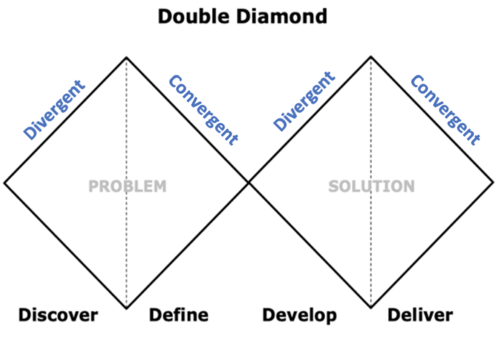Double diamond: A design process model
| Line 14: | Line 14: | ||
=== The Double Diamond & Project Management === | === The Double Diamond & Project Management === | ||
| − | The Double Diamond model involves four phases. The first two phases constitute the first diamond - the problem space. The other two phases constitute the second diamond - the solution space. Figure | + | The Double Diamond model involves four phases. The first two phases constitute the first diamond - the problem space. The other two phases constitute the second diamond - the solution space. Figure 1 visualizes the Double Diamond model. |
| + | [[File:DoubleDiamond.png|left|thumb|500px|Figure 1: Visualization of the Double Diamond model (Own figure based on the British Design Council, 2005)]]<br clear=all> | ||
| + | |||
| + | |||
| + | |||
== Bibliography == | == Bibliography == | ||
<references/> | <references/> | ||
Revision as of 09:40, 21 February 2021
Contents |
Abstract
This article describes the Design Thinking model Double Diamond with a particular focus on how the model is applicable in the context of project management and what limitations it holds. The Double Diamond model was developed by the British Design Council in 2005 based on case studies from Design Departments at 11 international companies[1]. The model was visualized by a figure consisting of two diamonds, in which the first diamond displayed the problem space and the second the solution space. The Double Diamond model describes four general stages, which can help the user to navigate through complex processes in a structured manner. Each of the four stages are characterized by what has been described as either divergent- or convergent thinking: Discover (Divergent), Define (Convergent), Develop (Divergent), and Deliver (Convergent). Thus, the principle is that the user is diverging before converging. The initial Discover-stage aims to investigate, explore and identify the stakeholder needs while simultaneously seeking to understand the complexity of the problem. The Define-stage delimits the interpretations based on the findings in the Discover-stage, aiming to obtain a clear definition of the problem. The third stage, Develop, aims to acquire various solutions, which can address the problem. The Deliver-stage entails final testing of the solutions pursuing an improved outcome followed by feedback sessions on the process. Connecting the model to the different project management life cycles shows that the Double Diamond is not a great fit for all types of life cycles, however the model still appears to be an appropriate Project Management framework in some cases, e.g., when running a project in a predictive life cycle aiming to obtain a structured project plan with a key focus on the problem- and solution space from the initial stages. Further, it is discussed that the model contains certain limitations, e.g., its structure has been criticized for being too linear, which does not align with today’s agile and iterative way of applying Design Thinking or Project Management.
The Double Diamond in the context of Project Management
Design Thinking & Project Management
The Double Diamond model was developed by the British Design Council in 2005 based on the concept of Design Thinking, which is defined and described by various authors (British Design Council, 2005). However, the majority of the authors, who have been involved with Design Thinking, associate the concept with subjects such as creative processing, problem solving and business innovation[2]. IDEO, an international design and innovation consulting firm, describes Design Thinking as followed:
“Design thinking has a human-centered core. It encourages organizations to focus on the people they're creating for, which leads to better products, services, and internal processes. The process starts with taking action and understanding the right questions. It’s about embracing simple mindset shifts and tackling problems from a new direction.“[3]
The Design Thinking approach fits well in the context of Project Management as it facilitates and encourages innovative solutions based on mainly human resources. Many common denominators exist between the two approaches, which is why the Design Thinking model Double Diamond can be tied to several specific processes within Project Management. The model discussed in this article fits the structuring and planning of Project Management, why the different life cycle concepts are reviewed based on the Project Management standards[4][5]. Specifically, it is addressed how the Double Diamond is applied in a predictive or adaptive life cycle.
The Double Diamond & Project Management
The Double Diamond model involves four phases. The first two phases constitute the first diamond - the problem space. The other two phases constitute the second diamond - the solution space. Figure 1 visualizes the Double Diamond model.
Bibliography
- ↑ Design Council. (2005). Eleven lessons: managing design in eleven global brands. A study of the design process. Chapter: The design process. Retrieved from https://www.designcouncil.org.uk/sites/default/files/asset/document/ElevenLessons_Design_Council%20(2).pdf
- ↑ Tschimmel, K. (2012). Design Thinking as an effective Toolkit for Innovation.
- ↑ IDEO. What is Design Thinking?. Last retrieved Februar 15, 2021. Retrieved from https://www.ideou.com/blogs/inspiration/what-is-design-thinking."
- ↑ Project Management Institute, Inc. (2017). Guide to the Project Management Body of Knowledge (PMBOK® Guide) (6th Edition).
- ↑ AXELOS (2017). Managing Successful Projects with PRINCE2 2017 Edition.
